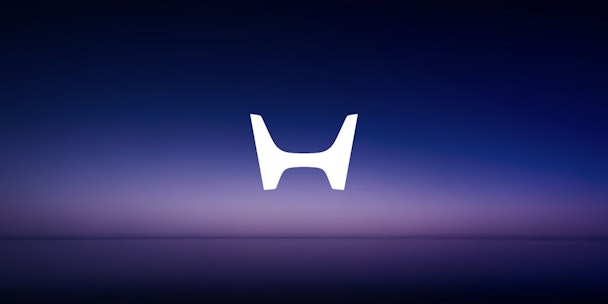Hi-fi, lo-fi, AI: an unexpected contrast in modern branding
Coley Porter Bell’s James Ramsden has spotted a widening chasm in modern branding between ultra-modern and classic design. What’s driving it?

Honda's rebrand
In the cinema at the weekend, watching the trailers, up popped Saltburn’s gothic mastery with its hand-drawn, gilded graphology. It was immediately followed by an ad for the Google Pixel 8 promoting its AI-enabled photo doctoring, so we can now appear to do the impossible. It was an interesting juxtaposition – and timely demonstration of the divergence creativity is currently experiencing.
As we look at branding in the coming year – and the impact that AI has and will continue to have on creativity – this emerging juxtaposition will be similarly evident in quite different aesthetics and approaches being adopted by brand design teams. And when I talk of AI’s impact, this is no gentle evolution; this is a revolution. It is the most monumental shift in branding talent’s lives, as artificial intelligence connects with human imagination, and that interconnection is felt across the design and branding world.
The result is that we’re seeing on one side hi-fi creativity – iterating and developing ideas and expressions at speed – and on the other a lo-fi direction, celebrating the hand-drawn and often retrospective individuality. So, for every increasingly slick animation or image creation, there is the charmingly crafted hand-drawn illustration or clumsy gif – all parts of the brand expression creative toolkit. As both are embraced, we are reaching a crossroads in creativity where we will explore AI-assisted creation alongside intentionally crafted design.
Advertisement
Look back to the future
In 2024, brands will continue to be inspired by their past, as we’ve already seen in several rebrands of the past year. When it comes to design, businesses are looking back to look forward – delving into their back catalogs to influence refreshes and rebrands. We saw this with Nationwide’s redesign last year, where the brief stipulated staying true to its heritage and the designer used the archives to find “a real design heritage.”
Meanwhile, Honda’s new H logo, which debuted on its electric 0 series cars, is more than a nod to the badge it sported in the 60s. Its new minimalist design – no longer framing the H and with outward sloping sides – references that earlier logo.
Why designers are looking into archives can be debated. Still, Nationwide and Honda have successfully looked at the past and made it feel very modern and fresh rather than a retrograde move.
The impact of AI on rebrands
As mainstream software companies bake AI into their platforms, it will become deeply integrated into our design worlds to support agencies and creatives with experimenting and creating workflows. Amid the growing, almost gold-rush-like number of sources, a few will rise to the surface and become hugely valuable to the creative process.
AI’s greatest asset is its speed, allowing things to be done quickly, innovatively and with relative ease (once you ‘learn the language’). The unexpected can be tested and explored in ways not previously possible.
Advertisement
Marketers can expect faster iterations and expressions at the beginning of a rebrand project – not a perfect answer instantly, but a more open and fluid approach to get to the answer. We can expect brands to change too – to be ever more immersive as, for instance, quick sound pallets are put together as easily as Pantone selections.
It ramps up the power of design by aiding surprising combinations of brand expressions. If last year was the learning phase, this year will be the incorporation phase where more unconscious use of AI will help augment and introduce surprise in the branding process.
In the coming year, we will specifically see the surge of AI ‘text to video.’ The past couple of years have seen rapid development of ‘text to picture,’ and the progress made with ‘text to video’ will deepen as designers explore the new boundaries of visual creation. Where – until very recently – we could instantly spot a fake, now we would struggle to tell the difference between a Hasselblad-shot image and one generated by AI. How long before we achieve a similar level of fidelity for video?
A tool for human ingenuity
There is an AI workflow for almost every conceivable part of the creative process. However, creatives will still think and make the connections from insight to idea in unusual and interesting ways. AI can be a partner helping us explore new ideas and increase our learning speed – it helps creatives work smarter.
Suggested newsletters for you
But it will change elements of branding; for example, brand guidelines won’t be about choosing images from Getty but will instead be guidelines on how to write AI prompts to create images. And as personalization increases, AI will help us shape brands to respond to this. For brands with a long history, AI can be trained on back catalogs of graphics, shapes, patterns and images to seed the process of creating new ones.
Those of us working in branding and design are at different stages of AI investment (both monetary and emotionally), and acceptance is mixed. But as we explore the hi-fi and the lo-fi, the human filter remains essential.

